 Most viewed - Asakusa 浅草 Most viewed - Asakusa 浅草 |

The oiran courtesan is escorted by two little girls called kamuro. 花の吉原おいらん道中2050 views
|
|
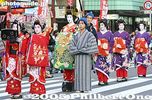
Oiran Dochu Procession. This is definitely the highlight of the festival, and my favorite part of the festival. 花の吉原おいらん道中1922 views
|
|
|

Oiran Dochu Procession1549 views花の吉原おいらん道中
|
|

This was the only one who had a smile. The others were quite serious and solemn.1349 views
|
|

Edo Geisha, She was the only one with a smile.1319 views
|
|

Hojo Masako worships at Asakusa Temple. 北条政子 浅草寺参拝1257 views
|
|
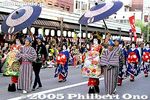
Oiran Dochu Procession. This picture was taken in the 1990s when they had two oiran in the festival. Now they have only one. 花の吉原おいらん道中1222 views
|
|

Mistress Okichi, the infamous mistress of Townsend Harris, America's first ambassador to Japan when he was in Shimoda. Another mistress was provided to Harris' interpreter.1219 viewsOkichi was the infamous mistress of Townsend Harris, America's first ambassador to Japan. Another mistress was provided to Harris' interpreter.
黒船来航・浦賀奉行
|
|

Tekomai geisha costume is partially masculine with trousers instead of skirts. Their right shoulder is "exposed" showing a flower design. They carry a red paper lantern imprinted with their names and use their right hand to drag a wand.1204 views"Asakusa" is written on her lantern. 手古舞
|
|

Oiran Dochu Procession1188 views
|
|
|

Oiran Dochu Procession1140 views花の吉原おいらん道中
|
|

Oiran Dochu Procession1057 views花の吉原おいらん道中
|
|

Ariwara no Narihira (825-880) comes to east Japan1050 views在原業平 東下り
|
|

Tekomai geisha1006 views
|
|
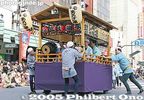
Sadly, the Tokyo Jidai Matsuri no longer held. It used to be held annually on Nov. 3 (Culture Day) in Asakusa, Tokyo.989 viewsthe Tokyo Jidai Matsuri (Festival of Historical Periods) is a parade tracing the history of Tokyo with over 1,600 people dressed in the respective period's costume. This is the lead float playing music. It took about an hour for the parade to reach Kaminarimon Gate.
Lead Float: Edo festival music played by children. Kodomo Edo-bayashi yatai
先導 子供江戸囃子屋台
|
|

She walks in a very slow and stylized way, her feet taking figure-8 steps. She needs the man's shoulder to steady herself.974 views
|
|

Oiran Dochu Procession in front of Kaminarimon Gate, Asakusa.954 views花の吉原おいらん道中
|
|

Edo Geisha907 views江戸芸者
|
|
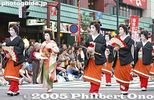
Edo Geisha. These geisha are from Asakusa, which also happens to be one of Tokyo's geisha districts. 江戸芸者856 views
|
|

Inner palace women847 views
|
|
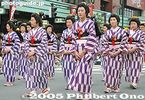
Inner palace women842 views
|
|

Edo Geisha835 views江戸芸者
|
|
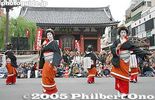
Edo Geisha819 views江戸芸者
|
|
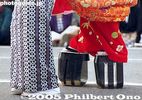
Oiran Dochu Procession. Her clogs. 花の吉原おいらん道中811 views
|
|

Shinsengumi801 views新撰組
|
|

Saruwaka Sanza, Edo Kabuki792 views猿若三座 江戸歌舞伎
|
|

Edo Geisha780 views江戸芸者
|
|

Oiran Dochu Procession. The two little girls are called kamuro.774 views
|
|
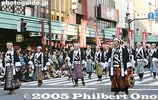
On Dec. 14, 1702, Asano's 47 masterless retainers avenged their master's death by attacking and beheading Kira at his residence in Ryogoku.772 views義士の討ち入り
|
|
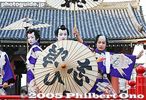
1624: Saruwaka Sanza, Edo Kabuki. Kabuki was started in the early Edo Period in 1624. Later, Edo's three licensed kabuki theaters named the Nakamura-za, Ichimura-za, and Morita-za were relocated to Asakusa in an area called Saruwaka.771 views"Sanza" means three theaters. 猿若三座 江戸歌舞伎
|
|

Shinsengumi disbanded when the shogunate collapsed and Emperor Meiji became the head of state. The Shinsegumi wore a distinct costume with a light blue haori. 新撰組757 views
|
|

Edo Geisha756 views江戸芸者
|
|
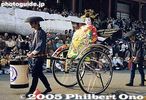
Oiran Dochu Procession. This picture was taken next to the Sensoji Temple behind which the parade starts. Before, one oiran courtesan rode in a rickshaw. 花の吉原おいらん道中745 views花の吉原おいらん道中
|
|

Firemen's Acrobatics718 views大岡越前守と江戸町火消
|
|
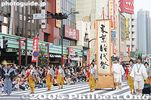
Tokyo Jidai Matsuri Banner and Tekomai geisha. From top to bottom, the banner reads, "Tokyo Jidai Matsuri." It marks the official and real start of the festival parade. The first Tokyo Jidai Matsuri was held in 1989. 東京時代祭本旗711 viewsThe first Tokyo Jidai Matsuri was held in 1989. Slight changes in the festival have been made since. Instead of two oiran courtesans, there is only one now. And at the end of the parade, the Asakusa Revue of showgirls used to be the anchor. But they are now gone.
東京時代祭本旗、手古舞
|
|

Edo Geisha 江戸芸者708 views江戸芸者
|
|
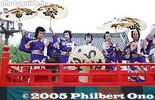
Saruwaka Sanza, Edo Kabuki. "Sanza" means three theaters. 猿若三座 江戸歌舞伎682 views猿若三座 江戸歌舞伎
|
|

Minamoto no Yoritomo (Hatakeyama Shigetada). His prayers for victory were answered. 源 頼朝 隅田川陣営 (畠山重忠)678 views
|
|

White Heron Dance is one of the highlights of the festival. It is also performed on other occasions in Asakusa. The dance was revived in 1968 in Asakusa to mark the Meiji Period Centennial. It has been performed annually on Nov. 3 ever since. 白鷺の舞671 views
|
|
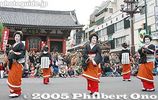
Edo Geisha portrayed by Asakusa geisha.647 views江戸芸者
|
|

Shrine maiden and Kaminarimon Gate in Asakusa646 views三社大権現祭礼 船渡御
|
|

Asakusa Folk Entertainment. Behind the Asakusa Temple, there was a variety of shows, street performers, plays, and other characters. Asakusa has always been Tokyo's entertainment center. 浅草奥山風景642 views
|
|
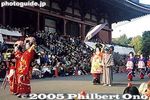
Oiran Dochu Procession 花の吉原おいらん道中615 views
|
|
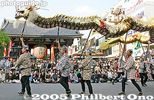
According to legend, three days after the golden Kannon statue was found, a golden dragon descended from heaven and danced. The mountain name of the temple is Kinryu-zan, meaning Golden Dragon Mountain. (Most temples have a mountain name.)599 views
|
|
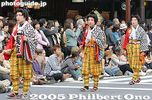
Tekomai geisha existed since the Edo Period. They served as side entertainment at festivals. They only sing traditional chant-like songs called kiyari originally sung by lumberers hauling wood. 手古舞569 viewsThese tekomai did not sing, so they might not be real. When they sing, they hold a fan to their mouth.
手古舞
|
|

Genroku Flower-Viewing Dance 元禄花見踊り564 views
|
|

Hagoita Honey557 views
|
|

Hagoita Honey554 views
|
|

Hagoita Honey poses in Asakusa553 views
|
|
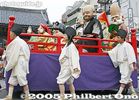
Seven Gods of Good Fortune 浅草市村座七福神舞549 views浅草市村座七福神舞
|
|

1717: Firemen's Acrobatics. Ooka Echizen no Kami Tadasuke (1677-1751) and Edo Fire Brigade. Ooka was a famous Edo magistrate who organized fire brigades in Edo. 大岡越前守と江戸町火消548 views
|
|

Firemen's Acrobatics546 views大岡越前守と江戸町火消
|
|

Hagoita Honey541 views
|
|

Genroku Flower-Viewing Dance532 views
|
|

Firemen's Acrobatics 大岡越前守と江戸町火消531 views
|
|

Year 1702: The 47 masterless retainers arrive to avenge their lord. In 1701 in the shogun's palace, Lord Asano Naganori draws his sword in a fit of anger and cuts Kira Yoshinaka, the highest-ranking master of protocol who had mocked Asano.521 viewsAsano was immediately forced to commit ritual seppuku. At the end of the following year, his 47 masterless retainers avenged their master's death by attacking and beheading Kira at his residence in Ryogoku. This story of loyalty soon becomes a timeless classic known as "Chushingura."
義士の討ち入り
|
|

Townsend Harris and Commodore Perry 黒船来航・浦賀奉行516 views
|
|

This story of loyalty soon becomes a timeless classic known as "Chushingura." 義士の討ち入り511 views
|
|

在原業平 東下り503 views
|
|

Sankin Kotai Daimyo Gyoretsu palanquin. This is how the daimyo traveled--in a comfortable box hand-carried by men. 参勤交代 大名行列499 views
|
|
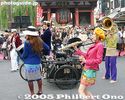
Asakusa Folk Entertainment. This was the last act. Somewhat tacky end to the festival.487 views
|
|

Magistrate Procession 奉行485 views
|
|

442 views
|
|
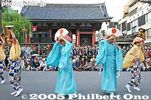
Asakusa Folk Entertainment 浅草奥山風景438 views
|
|

Lead float with Edo festival music played by children. The names of the children playing are written on the red lanterns hanging above. Kodomo Edo-bayashi yatai 先導 子供江戸囃子屋台434 views
|
|

Oiran Dochu Procession. Passing by Matsuya Dept. Store and Tobu Asakusa Station.433 views
|
|
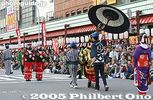
Oiran Dochu Procession430 views花の吉原おいらん道中
|
|
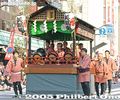
This page is a complete English guide to all the groups that appear in the parade. The parade assembles behind Sensoji Temple and starts at 1:30 pm from Nitenmon gate. The procession then goes down Umamichi-dori street, passes by Matsuya Department Store.419 views先導 子供江戸囃子屋台
|
|

Tokugawa Ieyasu takes up residence in Edo. 徳川家康 江戸入府415 views
|
|

Year 1603: Tokugawa Ieyasu becomes Shogun. He designates Asakusa Temple as a place of worship, and he worships there himself in 1616. Behind him is his son Tokugawa Hidetada who became the second Tokugawa shogun. 徳川家康 江戸入府411 views
|
|
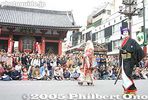
Hanakawa do Sukeroku & Ikyu (kabuki characters). Sukeroku and Ikyu vie for the love of a courtesan named Agemaki. 花川戸助六 意休411 views
|
|

The golden sculpture is atop the Asahi Beer building in Asakusa. It's supposed to be beer froth, but most people think it looks like doo-doo.409 views
|
|

Sankin Kotai Daimyo Gyoretsu 参勤交代 大名行列405 views
|
|

Asakusa: White elephant is usually present during Hanamatsuri. On the day before the Buddha's mother Queen Maya gave birth, she dreamed that a white elephant entered her womb.400 views
|
|

Sanja Festival393 views
|
|

Hanakawa do Sukeroku, a favorite son of Asakusa and famed womanizer. He was loved by the people since he sided with the weak and defeated the strong. Made into a kabuki character. 花川戸助六 意休388 views
|
|

Lord Ii Naomasa, a right-hand man of Tokugawa Ieyasu and major ally in the Battle of Sekigahara in 1600. Based in Hikone, Shiga Prefecture. 井伊直政 徳川家康 江戸入府386 views
|
|

Sensoji temple's Kaminarimon Gate. There's a large road in front and also a large paved area where festivals are held. 雷門381 views
|
|
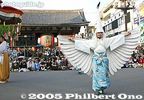
White Heron Dance376 views
|
|

Yabusame archer375 views
|
|

Ikyu, the villain. 花川戸助六 意休371 views
|
|
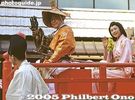
Ota Dokan, initial builder of Edo Castle. This is played by Shun'ichi Suzuki, the then governor of Tokyo. Body guards were around his float. He is dressed in a hunter's costume. Behind him is an attendant named Yamabuki.368 views江戸開祖 太田道灌、従者・山吹娘
|
|
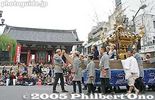
Third portable shrine. 三社大権現祭礼 船渡御361 views
|
|
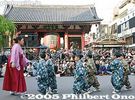
Tokyo Jidai Matsuri 三社大権現祭礼 船渡御360 views
|
|
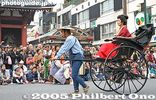
Cultural enlightenment: Higuchi Ichiyo (1872-96) was a critically-acclaimed novelist who also graces the 5,000 yen bill. At age 24, she died of tuberculosis. 文明開化 樋口一葉359 views
|
|
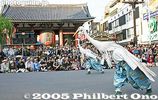
White Heron Dance in front of Kaminarimon Gate.356 views
|
|
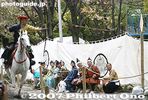
Arrow in mid-air. Asakusa Yabusame.353 views
|
|

I also saw the White Heron Dance in April 2010. It was slightly different. My YouTube video of the White Heron Dance in April 2010.353 views
|
|

From Matsuya Department Store, the procession turns right into Kaminarimon-dori street which passes in front of the famous, giant red lantern called Kaminarimon Gate. Lead float with Edo festival music played by children. 先導 子供江戸囃子屋台352 views
|
|
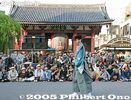
A magistrate (bugyo) in Edo could be a regional governor or government minister.349 views
|
|

The three-day Asakusa Sanja Matsuri is held during the weekend of the third Sunday of May. Numerous portable shrines (mikoshi) parade all over Asakusa amid huge crowds. Most of these photos were taken on May 17-18, 2008. (B/W ones taken some years ago.)339 views
|
|

Ariwara no Narihira (825-880) comes to east Japan. He was a Japanese waka poet and aristocrat. He was one of six waka poets referred in the preface in kana to Kokinshu by Ki no Tsurayuki. A woman portrays him. 在原業平 東下り336 views
|
|
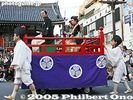
Year 1867: Tokugawa Yoshinobu, the 15th and last shogun who surrendered power to the emperor and fled Edo in 1868 following military defeat by powerful provincial lords seeking to return power to the Emperor. 第十五代将軍 徳川慶喜333 views第十五代将軍 徳川慶喜
|
|
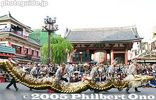
Golden Dragon Dance was first performed in 1958 to commemorate the reconstruction of Sensoji's main worship hall. 浅草のよろこび 金龍の舞330 views
|
|
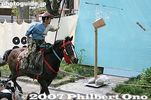
The wooden target boards have an envelope of confetti stuck on the back so it explodes when the target breaks apart.329 views
|
|
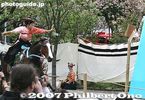
The crowd favorite was this high school girl. See the arrow pierce the wooden target.324 views
|
|
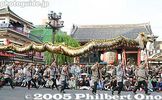
Golden Dragon Dance. No smoke or fire came out of the mouth. The dragon is 15 meters long, weighing about 80 kg. It has a bamboo frame, covered with cloth. Eight men use poles to manipulate the golden dragon.320 views
|
|

Edo Geisha318 views江戸芸者
|
|
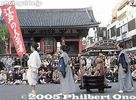
Edo's Popular People 江戸の人気者315 views江戸の人気者
|
|
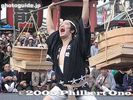
Edo's Popular People--Isshin Tasuke, a fish peddler and a very popular fictional character. 江戸の人気者(一新太助)314 views
|
|

1868: Transition from Edo to Tokyo (Saigo Takamori). With the Meiji Restoration in 1868, the ruler of Japan shifts from the shogun to an oligarchy ruling under the banner of the emperor. Edo is renamed Tokyo. 江戸から東京へ314 viewsWith the Meiji Restoration in 1868, the ruler of Japan shifts from the shogun to an oligarchy ruling under the banner of the emperor. Edo is renamed as "Tokyo (Tokio)," meaning "Eastern Capital," as ordered by Emperor Meiji.
江戸から東京へ
|
|

Tekomai geisha312 views
|
|

Asakusa Sanja Matsuri311 views
|
|

Edo Geisha308 views江戸芸者
|
|

Year 628: Two fishermen brothers find a golden Kannon buddha statue in Sumida River. The two fishermen were Hinokuma no Hamanari and Takenari. A wealthy landowner named Hajinomatsuchi heard about the statue and told the brothers about its religious value.303 viewsHe then built a small temple for the statue and the brothers converted to Buddhism. The temple eventually became today's Sensoji Temple (also called Asakusa Kannon Temple). Because of the temple, Asakusa developed and prospered and the two brothers and landlord are considered to be the founders of Asakusa.
Next to Sensoji Temple is Asakusa Shrine dedicated to these three men now deified. Asakusa Shrine holds the annual Sanja Matsuri in May, one of Tokyo's biggest festivals. Three portable shrines dedicated to these three men are carried around the streets of Asakusa. "Sanja" means three shrines or gods.
檜前浜成(ひのくまのはまなり)・竹成(たけなり)の兄弟の網に一体の小さなご仏像がかかりました。
東京のあけぼの 浅草観音示現
|
|
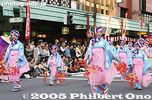
Genroku Flower-Viewing Dance. The Genroku Period was 1688-1704, a time of cultural flowering among the masses. 元禄花見踊り302 views
|
|
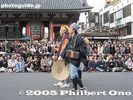
Edo's Popular People: Mito Komon, an important lord related to the Tokugawa Shogun. He was based in Mito, Ibaraki Pref. Most people know him through the popular Mito Komon TV series.297 views Most people know him through the popular Mito Komon TV series where he is shown traveling around incognito to help people being oppressed by corrupt officials, etc. When he reveals his real identity to the villains, they instantly go down on their knees and maybe even poop in their pants.
江戸の人気者
|
|
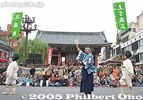
Shinsengumi was a Kyoto-based, pro-shogunate group of skilled swordsmen of Edo and masterless samurai in Kyoto formed to suppress the growing opposition (especially from Choshu) against the shogunate in favor of restoring the Emperor to power. 新撰組295 viewsThe group disbanded when the shogunate collapsed and Emperor Meiji became the head of state. 新撰組
|
|

Edo Geisha294 views江戸芸者
|
|
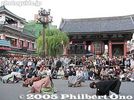
Mito Komon: He travels around incognito to help people being oppressed by corrupt officials, etc. When he reveals his real identity to the villains, they instantly go down on their knees and maybe even poop in their pants.293 viewsBowing to Mito Komon.
江戸の人気者
|
|
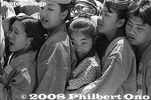
Asakusa Sanja Matsuri291 views
|
|

Sanja Matsuri: Not sure if this is a geisha group or a kabuki group.291 views
|
|

Inner palace women. 大奥御殿女中289 views
|
|
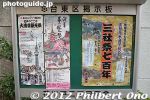
To mark the 700th anniversary of Asakusa Sanja Matsuri Festival in 2012, a boat procession was held on Sumida River on March 18, 2012. The last time they did this was in 1958. 288 views
|
|
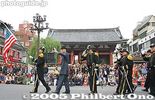
Townsend Harris and Commodore Perry, played by Americans from Yokosuka Naval Base. 黒船来航・浦賀奉行287 views
|
|

Like most major Buddhist temples, Sensoji temple in Asakusa holds its Hanamatsuri to mark Buddha's birthday on April 8. Hana Matsuri sign at Kaminarimon Gate.286 views
|
|
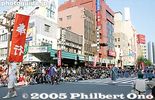
Magistrate Procession 奉行284 views
|
|
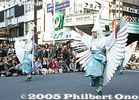
The scroll showed the White Heron Dance being performed for peace when the temple completed a major renovation. 白鷺の舞284 views
It is one of the highlights of the festival. It is also performed on other occasions in Asakusa.
白鷺の舞
三社大権現祭礼 船渡御
|
|

Edo Geisha281 views江戸芸者
|
|

Asakusa Hagoita-ichi Battledore Fair, Dec. 17-19278 views
|
|
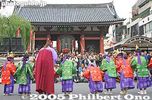
Magistrate Procession. Bowing to Asakusa Temple.277 views
|
|

Symbol of Tokyo: Kaminari-mon Gate with a giant red paper lantern. Pass through this gate to reach Asakusa Kannon Temple. 雷門275 views
|
|
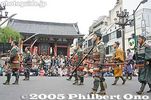
Minamoto no Yoritomo 源 頼朝 隅田川陣営273 views
|
|
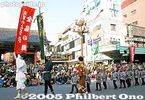
271 views
|
|

In front of Sensoji temple's Hozomon Gate are battledore stalls on both sides.268 views
|
|
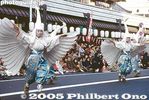
The White Heron Dance originated in Kyoto over 1,100 years ago to purge the city of an epidemic.266 views
|
|

Asakusa Sanja Matsuri in front of Sensoji temple.265 views
|
|

Arrival of Black Ships 黒船来航・浦賀奉行264 views黒船来航・浦賀奉行
|
|

Binzasara Dance from Asakusa Shrine. This dance also originated in Asakusa by farmers who celebrated the completion of a tea house in Asakusa near the Asakusa Sensoji Temple. It is now a dance to celebrate a good harvest. びんざさら舞261 views
びんざさら舞
三社大権現祭礼 船渡御
|
|

On the second day (Sat.) of the Asakusa Sanja Matsuri at noon, numerous mikoshi (portable shrines) gather behind Sensoji temple, and wait their turn to depart for the streets of Asakusa.261 views
|
|
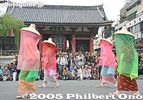
在原業平 東下り260 views
|
|
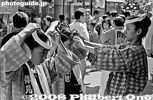
Sanja means "Three Shrines," dedicated to the two fishermen who found the Kannon buddha statue and the wealthy landlord who converted them to Buddhism. The statue became the object of worship that founded Sensoji Temple.260 views
|
|

Asakusa Sanja Matsuri258 views
|
|

Asakusa Hagoita-ichi Battledore Fair, Dec. 17-19257 views
|
|
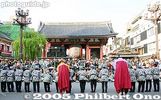
Golden Dragon Dance. 浅草のよろこび 金龍の舞256 views
|
|

The 25th Asakusa Yabusame horseback archery was held on April 21, 2007 at Sumida Park.253 views
|
|

251 views
|
|

Sarutahiko, Guardian of the earth. 猿田彦 三社大権現祭礼 船渡御246 views
|
|

White Heron dancers were silent and sang nothing as the musicians played.243 views
|
|

White elephant and the pagoda at Sensoji temple, Asakusa on Buddha's birthday called Hanamatsuri.243 views
|
|

Shirasagi-no-Mai dancer at Asakusa.242 views
|
|

Battledore240 views
|
|

Their costume is quite elegant whichever way you look at it. Shirasagi-no-Mai White Heron Dance, Asakusa.239 views
|
|

237 views
|
|

Peace monument237 views
|
|

One of many Buddha statues within the temple grounds.237 views
|
|

Golden Dragon Dance236 views
|
|
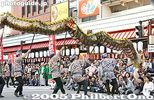
Golden Dragon Dance236 views
|
|

Forces of Minamoto no Yoritomo (1147-1199), the founder and the 1st shogun of the Kamakura Period, who ruled from 1192 until 1199. He is said to have prayed at Asakusa Temple for victory over the Taira Clan to become shogun. 源頼朝 隅田川陣営236 views源 頼朝 隅田川陣営
|
|
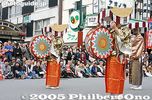
The Binzasara is a musical instrument made of 108 strips of white cedar wood strung together at the top. It is held on both ends and shaken in a wave motion to make a sharp wood clapping sound. It is also accompanied by drums as seen here.235 viewsびんざさら舞
三社大権現祭礼 船渡御
|
|

235 views
|
|

This White Heron Dance troupe consists of 3 warriors, 1 baton twirler, 1 feeder, 1 grand-umbrella holder, 8 white herons, 19 musicians and guardian children in traditional costumes of the Heian Period.234 views
|
|

Golden Dragon Dance (Kinryu no Mai).234 views
|
|

Golden Dragon Dance231 views
|
|

Hojo Masako (1156-1225), wife of Minamoto no Yoritomo, worships at Asakusa Temple. As the wife of the first shogun and mother of the second and third shoguns, she was a powerful lady. 北条政子 浅草寺参拝231 views
|
|

Giant red paper lantern with the kanji characters "Kaminari Mon." The gate was reconstructed in 1960. The previous one was lost in a fire in 1865.231 views
|
|
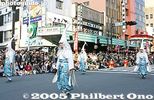
White Heron Dance, called Shirasagi no Mai, was revived in 1968 by the Asakusa tourist federation. Originating from the Heian Era, the dance was depicted in a picture scroll owned by the Sensoji Temple. 白鷺の舞228 viewsIt shows the dance being performed for peace when the temple completed a major renovation.
The dance troupe consists of 3 warriors, 1 baton twirler, 1 feeder, 1 grand-umbrella holder, 8 white herons, 19 musicians and guardian children in traditional costumes of the Heian Period.
It is one of the highlights of the festival. It is also performed on other occasions in Asakusa.
白鷺の舞
三社大権現祭礼 船渡御
|
|

Year 1590: Tokugawa Ieyasu takes up residence in Edo. His procession. 徳川家康 江戸入府228 views
|
|

The Shirasagi-no-Mai white heron dancers pass through Kaminarimon Gate in Asakusa.227 views
|
|

Hojo Masako worships at Asakusa Temple226 views
|
|

Asakusa Hagoita-ichi Battledore Fair, Dec. 17-19223 views
|
|

Never too busy for a phone call.223 views
|
|

The mikoshi passes under Kaminarimon Gate, a symbol of Asakusa. The giant red lantern is collapsed upward to make room.223 views
|
|

White Heron Dance (Shirasagi no Mai).223 views
|
|
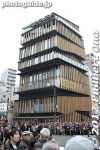
New building for Asakusa Tourist Information Center.222 views
|
|
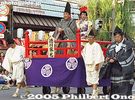
1649: Tokugawa Iemitsu. In 1649 during his reign as shogun, Asakusa Shrine was built. 徳川家光 三社権現社再建寄進220 views
|
|
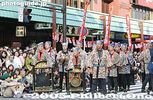
Golden Dragon Dance musicians216 views
|
|
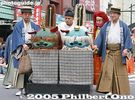
Binzasara Dance215 views三社大権現祭礼 船渡御
|
|

215 views
|
|

One of Tokyo's most photographed buildings: Kaminari-mon Gate with a giant red paper lantern.214 views
|
|

Sweet tea is poured over a statue of a baby buddha. According to legend, sweet rain (or perfumed water) fell when the Buddha was born.214 views
|
|

White Heron Dance rear view213 views
|
|
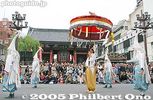
White Heron Dance211 views
|
|
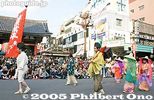
Ariwara no Narihira (825-880) comes to east Japan 在原業平 東下り207 views
|
|

Clearing the way down Nakamise. On the way back, they turned right into another temple and did not go all the way down Nakamise. 206 views
|
|

White Heron Dance, Asakusa206 views
|
|

Sankin Kotai Daimyo Gyoretsu204 views参勤交代 大名行列
|
|

Sanja portable shrines on boats. Sanja means "Three Shrines." The three fishermen who found the Kannon buddha statue (the origin of Sensoji Temple) are deified by Asakusa Shrine next to Sensoji Temple. 三社大権現祭礼 船渡御203 viewsThis is the first portable shrine. The portable shrines used to be paraded in a boat.
三社大権現祭礼 船渡御
|
|

Binzasara Dance from Asakusa Shrine. They also throw confetti during the dance.202 viewsThis dance also originated in Asakusa by farmers who celebrated the completion of a tea house in Asakusa near the Asakusa Sensoji Temple. It is now a dance to celebrate a good harvest.
The Binzasara is a musical instrument made of small pieces of white cedar wood strung together at the top. It is held on both ends and shaken in a wave motion to make a sharp wood clapping sound.
びんざさら舞
三社大権現祭礼 船渡御
|
|

They sang a few songs. Their parents toting video camcorders recorded the event.201 views
|
|
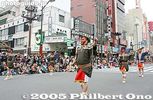
1635: Sankin Kotai Daimyo Gyoretsu. The daimyo was a warlord who owned and supervised a fief. Tokugawa Iemitsu started the Sankin kotai system where all daimyo were required to visit Edo annually at great expense. 参勤交代 大名行列200 viewsThe daimyo was a warlord who owned and supervised a fief. Tokugawa Iemitsu started the Sankin kotai system where all daimyo were required to visit Edo annually at great expense since they traveled in a large contingent.
参勤交代 大名行列
|
|
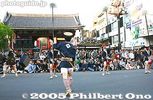
Sankin Kotai Daimyo Gyoretsu. "Gyoretsu" means procession. It was a great expense since they traveled in a large contingent. 参勤交代 大名行列199 views
|
|

White Heron Dance, Shirasagi no Mai. The eight white herons represent four male and four female herons.196 views
|
|

White Heron Dance, Asakusa196 views
|
|
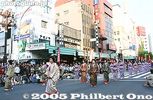
Inner palace women 大奥御殿女中192 views
|
|

Hondo worship hall altar 本堂191 views
|
|
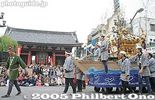
Second portable shrine. 三社大権現祭礼 船渡御187 views
|
|

Nakamise-dori souvenir arcade. One of Japan's most popular and crowded tourist arcades.187 views
|
|
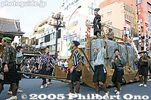
Edo Castle construction: Rock-hauling procession. Not a real boulder.186 views
|
|
|

Pretty orchid. It had a water capsule at the end of the stem. At the top were buds which later bloomed. This flower lasted me well over a month before it withered.184 views
|
|
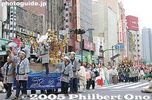
Asakusa Shrine holds the annual Sanja Matsuri in May, one of Tokyo's biggest festivals. Three portable shrines dedicated to these three fishermen are carried around the streets of Asakusa. "Sanja" means three shrines or gods. Portable shrine183 viewsSecond and third portable shrines.
三社大権現祭礼 船渡御
|
|

Hozomon Gate, means "Treasure Storage Gate." Indeed, the second floor houses important cultural properties. The gate was reconstructed in 1964, a ferroconcrete building.宝蔵門183 views
|
|

1608: Ieyasu orders Edo Castle expansion: Rock-hauling procession. Big boulders were hauled from Izu Peninsula's east coast. 江戸城築城 お石曵き182 views
|
|

Trinkets182 views
|
|

Asakusa Sanja Matsuri182 views
|
|

Information on the date/time when the dance is held is posted at e-asakusa.jp. Note that the time may vary. Last year they started at 3:30 pm instead of 2:30 pm this year.182 views
|
|

Tokugawa Ieyasu takes up residence in Edo and founds the Tokugawa or Edo Period that lasted until 1868.181 views徳川家康 江戸入府
|
|

The last time they did this was in 1958. The original Sanja Matsuri was actually a boat procession on Sumida River held in March 1312 (Kamakura Period).181 views
|
|

Behind Hozomon Gate is a pair of giant straw sandals hanging on the wall.180 views
|
|
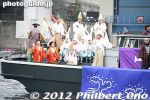
White Heron Dancers on a boat.180 views
|
|

Sankin Kotai Daimyo Gyoretsu179 views参勤交代 大名行列
|
|

5-story pagoda reconstructed in 1973, made of ferroconcrete. Roof tiles made of aluminum alloy. 五重塔179 views
|
|

About Hanamatsuri in Japanese.179 views
|
|

Taiko drummer178 views
|
|
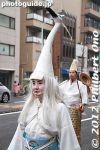
177 views
|
|
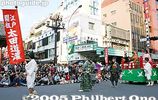
Year 1457: Ota Dokan, initial builder of Edo Castle. 江戸開祖 太田道灌、従者・山吹娘176 views
|
|

Incense burner. Pat the smoke to the part of your body that needs to be healed.176 views
|
|

White Heron Dance175 views
|
|
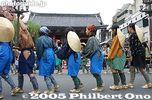
Edo Castle construction: Rock-hauling procession175 views江戸城築城 お石曵き
|
|

A higher view.175 views
|
|

Edo Castle construction: Rock-hauling procession. 江戸城築城 お石曵き174 views
|
|

Asakusa Hana Matsuri 花まつり173 views
|
|

The same man some years before??172 views
|
|

To mark the 700th anniversary of Asakusa Sanja Matsuri Festival in 2012, a boat procession was held on Sumida River on March 18, 2012. 172 views
|
|

Kimono shop171 views
|
|
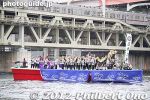
Boat carrying Golden Dragon. They didn't dance on the boat.170 views
|
|
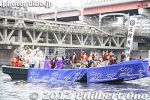
Boat carrying gods of good fortune and White Heron Dancers.170 views
|
|
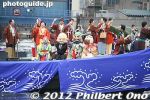
Gods of Good Fortune on a boat.170 views
|
|

Sankin Kotai Daimyo Gyoretsu in front of Kaminarimon Gate.169 views参勤交代 大名行列
|
|

169 views
|
|

Hanamatsuri sign168 views
|
|
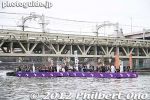
Flat barge with the three mikoshi cruising on the Sumida River. It has been 54 years since the last time this boat procession was held in 1958.167 views
|
|

Mikoshi drummer166 views
|
|

Festivals are tiring.166 views
|
|
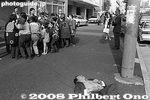
166 views
|
|

Mikoshi and the infamous beer sculpture.165 views
|
|
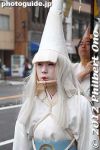
163 views
|
|

Dolls representing three of Asakusa's most famous festivals appear. This is Sanja Matsuri. On the right, notice the foreign woman doll with blond hair.161 views
|
|

Under the lantern on the gold cap, there's "Matsushita Denki" (Matsushita Electric Industrial Co. or Panasonic). The current Kaminarimon Gate and giant lantern were rebuilt in 1960 as a donation by Konosuke Matsushita.159 views
|
|

After passing through the Kaminarimon Gate, this is what you see: Nakamise shopping arcade. When it rains, a canopy is put up.159 views
|
|

Bull's eye. This is the third and last target along the course. It is quite difficult to hit all three targets, especially the last one.158 views
|
|

Small Kannon statues for 25,000 yen.158 views
|
|

Water fountain 沙竭羅龍王像158 views
|
|

Inside Hondo worship hall 本堂158 views
|
|

From 12:30 pm, amid a sea of people, the mikoshi leave one after another. 観音本堂裏広場に集合157 views
|
|
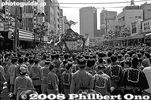
Kaminarimon-dori road during Sanja Matsuri155 views
|
|

The lantern is covered with a protective net. The lantern can be collapsed like an accordion to allow tall objects (such as a mikoshi portable shrine during the Sanja Matsuri festival) to pass under the gate. It is also collapsed during typhoons.154 views
|
|
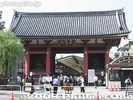
An unusual time when the giant lantern was removed for repairs. Asakusa looks very strange, almost naked, without the giant lantern.154 views
|
|
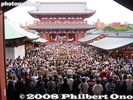
A sea of people in front of Sensoji temple in the area I call "The Pit."154 views
|
|
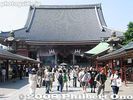
Hondo worship hall was reconstructed in 1958, made of ferroconcrete. The original Hondo was built in 1649 and a National Treasure until it was destroyed during World War II. 本堂152 views
|
|

Painting on ceiling of Hondo worship hall.152 views
|
|

View from Hondo worship hall151 views
|
|

The Shirasagi-no-Mai White Heron Dance is performed in Asakusa on the second Sunday of April and on Nov. 3. On April 11, 2010, I found them on the main road at around 2 pm. The mans holds a banner reading "Shirasagi-no-Mai."150 views
|
|

A symbol of Hanamatsuri (literally "flower festival") is the white elephant which is paraded around. This one stands ready at Kaminarimon Gate. It has a baby Buddha statue on top.150 views
|
|
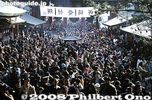
Crowd during New Year's149 views
|
|

Above the Asakusa Tourist Information Center is this clock which opens and chimes every hour. This clock is no more since a new building for the tourist information center opened in April 2012.148 views
|
|

The temple is also called Kinryuzan, meaning Golden Dragon. 金龍山147 views
|
|

In spring, a cherry blossom motif is put up.147 views
|
|

A mikoshi in front of Asakusa Shrine.147 views
|
|
| 834 files on 4 page(s) |
1 |
 |
|